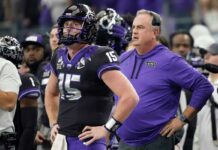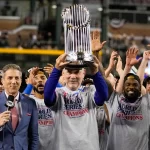Death in sports is not something we see everyday. It’s not something we are accustomed to seeing – it’s rare, very rare – but it does occur. It happened this week when IndyCar driver Justin Wilson succumbed to a head injury sustained in a wreck Sunday at Pocono Raceway. Wilson, who was 37, was hit in the head by a flying piece of debris from another car that had crashed in front of him.
This is the second time in four years that IndyCar has lost one of its drivers in a race (Dan Wheldon passed away from head injuries sustained in a 2011 crash in Las Vegas). Wilson’s death, as it should, has opened up the debate again about the safety of open pit vehicles in IndyCar and Formula One and what potential safety  changes can be made to further protect the drivers.
changes can be made to further protect the drivers.
It’s not surprising that changes in sports often occur in the aftermath of an injury (or injuries) to athletes. Rules are tweaked or implemented to provide an enhanced environment of safety for the athletes, even as equipment advances increase the speed of many games, and the athletes themselves continue to get bigger, stronger and faster. Those that wield the power in the major sporting leagues have to make difficult decisions at times based solely on the safety of their players (i.e. their investments), and make hard changes that fans and athletes alike may not approve of when initially instituted.
In 1978 the NHL mandated the wearing of helmets for all incoming players, something that spectators and players both found distasteful at the time – but now its hard to imagine the game being played without the protective headgear. Younger fans look on with skepticism today when told that goalies didn’t even wear masks until Jacques Plante first donned his crude version of the Jason Voorhees look (Friday the 13th) during the 1959-60 season for the Montreal Canadiens. But changes in the game demanded changes in player safety and equipment, and alterations were made.
The NFL, now dealing with legal issues from lack of player safety measures in the past, has installed a slew of new rules and protocols over the past few seasons with the hopes of decreasing the head injuries that so many former players are now suffering the effects from, including rules that outlaw head-to-head collisions and targeting…things that fans stood and cheered for in the past.

Major League Baseball made a rule change last year to eliminate collisions between runners and catchers at home plate. The rule came into play after a May 2011 crash that left San Francisco catcher Buster Posey with a broken leg and out for the season. Posey, like every all-star caliber athlete, is an extremely valuable commodity to the Giants, and owners don’t want to see their investments watching games from the press box. So they adapted and made changes.
Well it’s now time for MLB to adapt once again. Not to protect those that play their game this time, but to protect those that pay money to watch it in person.
Baseball fans have been getting injured at games at an alarming rate this season, from either line-drive foul balls or errant bats flying into the stands. On Sunday a fan was struck by a screaming foul ball of the bat of Cubs rookie Kyle Schwarber at Wrigley Field. The fan was sitting in a section just beyond the first base dugout. Just an inning later, another fan sitting behind the third base dugout was hit by a bat lost on a swing by another Cubs rookie, Addison Russell. Both fans were treated briefly in the stands and remained to watch the game.
A woman sitting behind the third base dugout at Comerica Park last Friday night for the game between the Rangers and Tigers wasn’t as lucky as those Cubs fans were. I happened to be watching the game when the line-drive foul ball off the bat of Tigers’ center fielder Anthony Gose struck her in the head. Play was delayed for over ten minutes while she was attended to by paramedics as players and fans alike watched on in stunned silence. She ultimately had to be carried out in a neck brace and on a stretcher.
Just last night in Philadelphia another female fan was struck in the forehead with a foul ball off the bat of Freddie Galvis of the Phillies. The team said she was examined and luckily didn’t need to make a hospital visit either.
Without doubt the most frightening moment this year (so far) occurred back in June at Fenway, when a woman was hit with a broken bat and her injuries were so severe they were classified as “life threatening.”
injuries were so severe they were classified as “life threatening.”
So why are all these injuries to fans happening now in such large numbers? It’s tough to say for sure, but players are without doubt bigger and stronger then they were in years past, which leads to balls coming off bats at faster rates. But I also think that many fans now, to be honest, spend as much time looking at their cell phones as they do alertly watching play on the field – and in this texting, emailing, streaming video and social media world that we live in today that’s not likely to change anytime soon. And all it takes is a split second of distraction for something really bad to happen.
In March of 2002, 13-year-old hockey fan Brittanie Cecil was struck in the head by an errant puck while attending a Columbus Blue Jackets game. Two days later she tragically died from her injuries. I was working in the front office of the Dallas Stars at the time, and I can tell you that the players from that game, and the league as a whole, were devastated.
The following season the NHL instituted nets that extended up from the safety glass behind the goals, protecting the fans in the most dangerous areas of the stands. We experimented with different types of filaments, in a myriad of colors, trying to find the least intrusive netting we could find – one that fans would still be able to see through without too much obstruction. Was it perfect? Of course not. Fans had to look through an obstacle whereas before it was just wide open space. But now, 12 years later, everyone is used to it and no one thinks twice about it. And fans can watch the game from those seats without fear of mortal injury.

Baseball Commissioner Rob Manfred said yesterday there was “a chance” that extra safety nets could be put up around the majors as early as next season. “We are examining all of the relevant information,” Manfred said. “Our goal to is to put the commissioner’s office in a position where we can make a complete recommendation to ownership in November and give people an opportunity to be ready to make changes for next year if, in fact, we decide that changes are necessary.”
A little background on the idea of extending the nets out from just behind home plate: During each of the last two labor negotiations the MLB Players Association requested extending safety nets down both foul lines to protect the fans, but the league (the owners) rejected the proposals, citing “concerns that additional netting would detract from ticket buyers in certain premium seats,” which could be interpreted by some as “we wont be able to demand as high of a ticket price if the premium seats views are obstructed by netting.” Players obviously don’t want to be responsible for injuring fans, and if owners foolishly decide to pass on regulating additional netting, responsibility for fan injuries (or worse) should fall squarely on their collective shoulders, if not legally then certainly morally.
But what if baseball does the right thing and implements new netting next season? Will it take some to time for fans to get accustomed to it? Of course it will. Will it take some experimenting to find the right materials and the correct angles as to obstruct the view as minimally as possible? Without a doubt. Will fans grumble and complain about it like children who are made to eat their vegetables or do their homework? I’m sure they will. But sometimes in life the things that are in your best interest don’t always appear as the most desirable at first glance.
But the bottom line is MLB has the opportunity to do something now before a real tragedy strikes. If they don’t want to make the necessary changes for the safety of their fans, then they should do it for the sake of their athletes. Just ask Espen Knutsen. Knutsen was the Blue Jackets’ player that fired the (deflected) puck into the stands some thirteen years ago, a puck which ultimately took the life of a teenage girl. The now 43-year-old Knutsen who is coaching back in his native Norway says it still haunts him. “It really shook me, my teammates and everyone around the team…more than people could ever know.”









